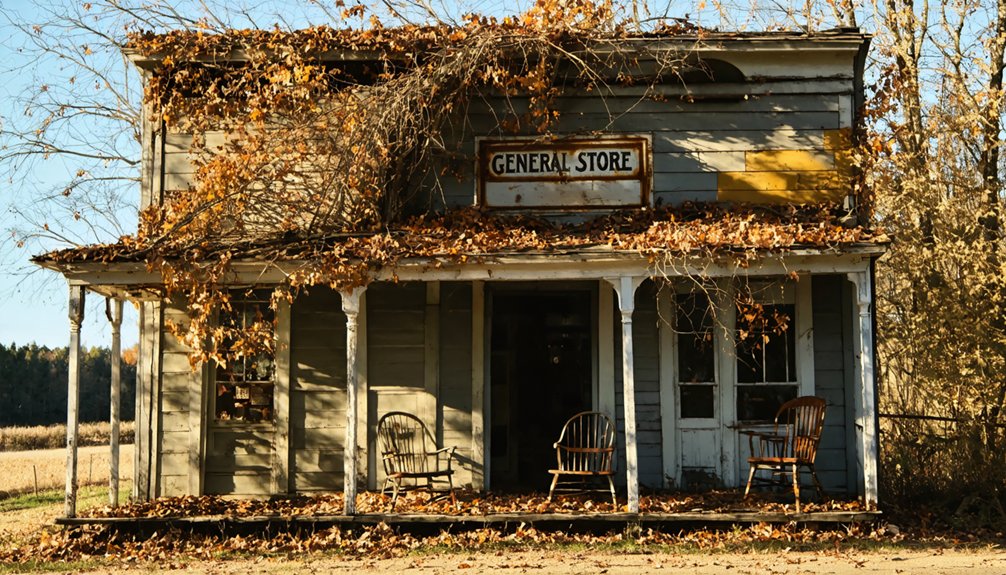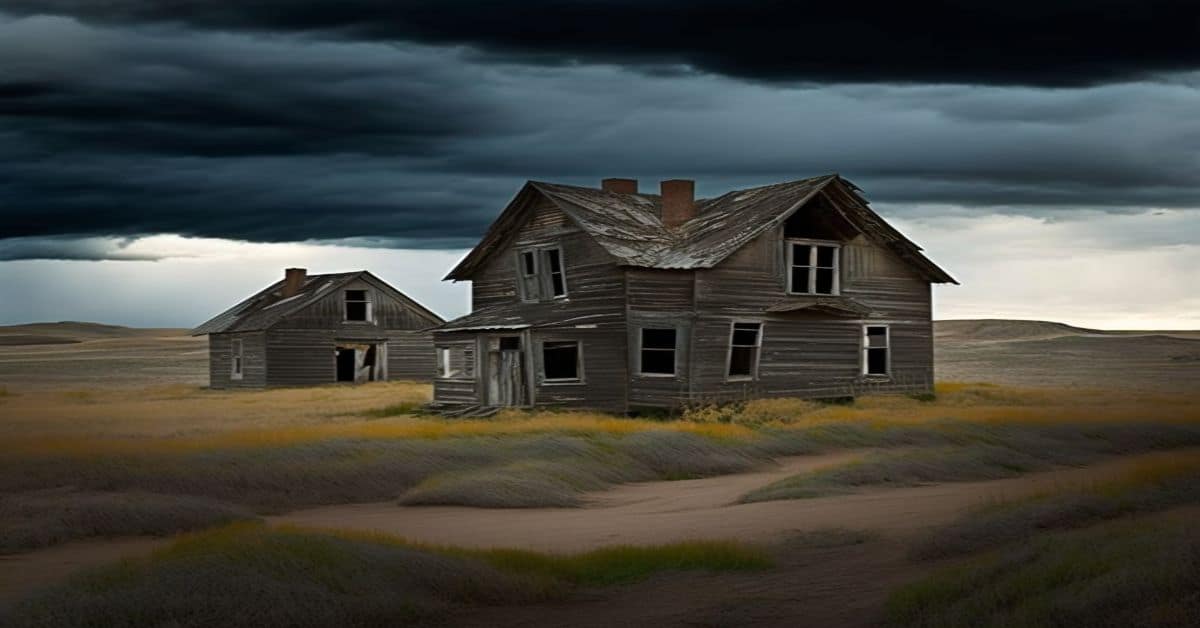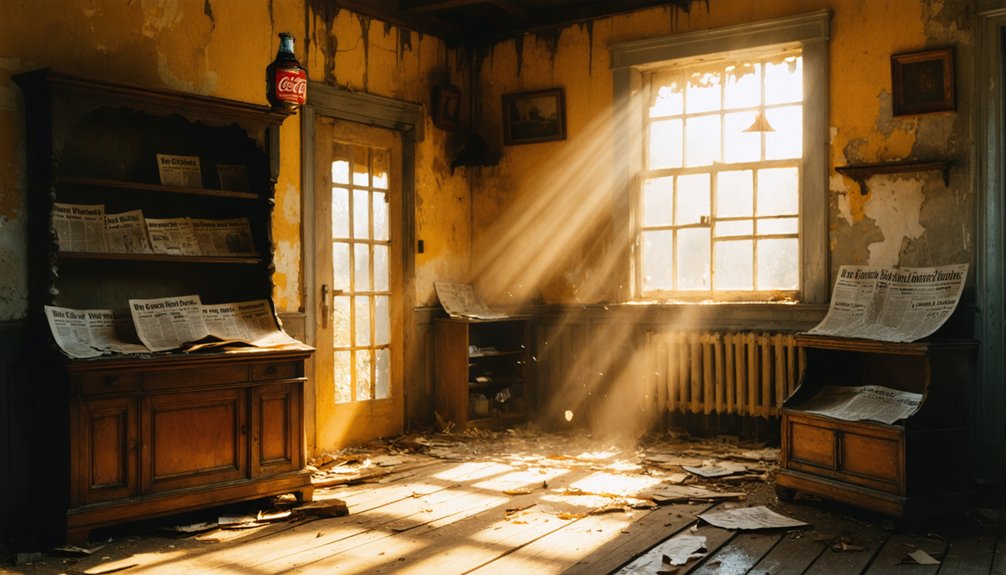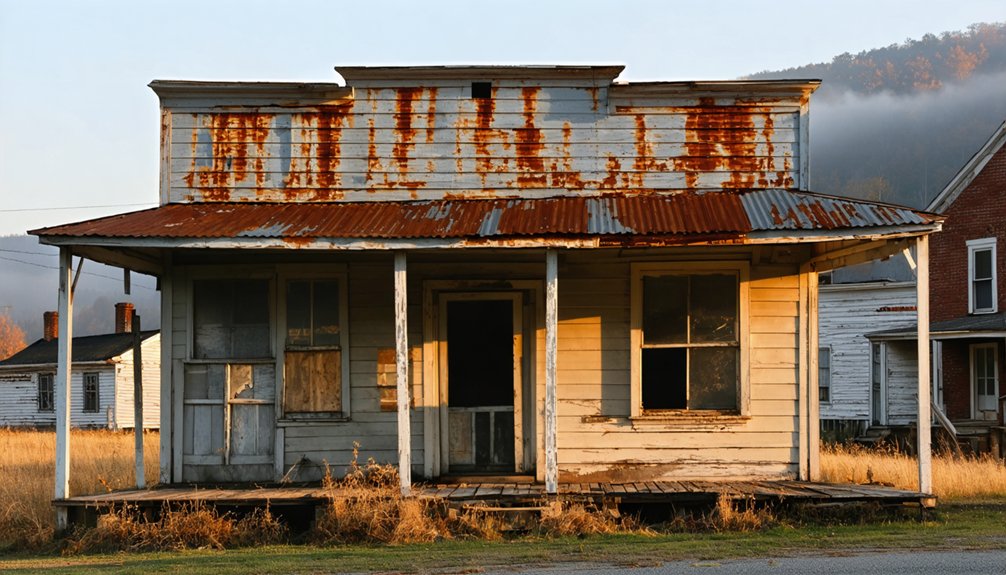You’ll find Scuffletown’s remains along the Ohio River in Henderson County, Kentucky, where Jonathan Stott’s tavern once hosted legendary brawls between Cherokee traders and flatboatmen in the early 1800s. The town thrived on tobacco trade and cultural exchange until devastating floods in the early 1900s forced folks to abandon ship. While nature’s reclaimed most traces, the rich tales of Scott Fox, Mary Polly Cooper, and their mixed-heritage community still echo through these Kentucky bottomlands.
Key Takeaways
- Scuffletown was a riverside trading post in Henderson County, Kentucky, established around 1800 and named after frequent fights at Jonathan Stott’s tavern.
- The town flourished as a vital Ohio River trading hub, with tobacco exports and a bustling tavern serving flatboatmen and Cherokee traders.
- A mixed settler-Cherokee community developed, led by Jonathan Thomas Scott and his Cherokee wife Mary Polly Cooper.
- The devastating flood of 1913 severely damaged the town, followed by the post office closure in 1914.
- The catastrophic 1937 flood completely destroyed Scuffletown, transforming it into an abandoned ghost town reclaimed by nature.
The Origins Behind the Name
The rough-and-tumble nature of Scuffletown earned its memorable moniker from the frequent fights and scuffles that broke out at Jonathan Stott’s tavern. You’d often find a lively mix of river travelers and locals throwing down after one too many drinks, creating quite the reputation for this Kentucky settlement.
The scuffle culture wasn’t limited to tavern gatherings, though. Cherokee stickball games and wrestling matches added their own flavor to the town’s rowdy character. Located in Henderson County, Kentucky, the town was known for its colorful history of confrontations.
During the Civil War, the town became an important stop for Union patrol boats providing protection to the residents.
These physical confrontations became so commonplace that folks naturally started calling the place Scuffletown, and the name stuck like mud on river boots.
Between the flatboatmen looking to blow off steam and the locals ready to prove their mettle, you couldn’t find a more fitting name for this spirited riverside community.
Early Settlement and Founding
While folks were busy scufflin’ and brawlin’, a man named Jonathan Thomas Scott – better known as Scott Fox – laid down roots that’d shape this riverside community for generations to come.
As the third son of Shawnee chief Cornstalk, Fox brought a unique heritage to the settlement patterns of early Kentucky when he established his tavern ’round 1800.
The community dynamics started takin’ shape when Fox married Cherokee woman Mary Polly Cooper, and together they built more than just a family – they created a thrivin’ hub along the Ohio River.
Their tavern became the heart of trade, where river folk’d stop to rest and resupply. Fox’s strategic choice of location, about 12 miles northeast of Henderson, made it a natural gatherin’ spot for flatboatmen and traders alike. The area saw steady growth as commercial activity flourished after the settlement’s establishment.
The establishment earned its reputation as Scuffletown Landing due to the frequent fights that broke out among patrons at the tavern between 1800 and 1804.
Life Along the Ohio River
Situated at a prime spot along the Ohio River, Scuffletown’s daily life revolved ’round the steady stream of flatboats pullin’ up to trade and rest.
The tavern served as the heart of river life, where you’d find Cherokee folks playin’ stickball alongside weary travelers lookin’ for a drink and a warm meal.
Community interactions weren’t always peaceful, mind you. The tavern earned its rough reputation from the frequent scuffles breakin’ out after too many spirits, even leadin’ to the tragic shootin’ of tavern keeper Scott in 1838.
But it wasn’t all trouble – the deep, navigable waters made for good trade, and the mix of Cherokee, Shawnee descendants, and river folk created a unique culture where traditional games and river commerce blended naturally along the waterfront.
Native American Heritage and Influence
Y’all mightn’t know it, but long before Scuffletown became a riverboat stop, Cherokee traders set up a small outpost here to swap goods with other tribes moving along the Ohio.
The settlement’s founder, James Scuffle, had Cherokee ancestry through his mama’s side, which helped him establish good relations with Native folks passing through.
The mixing of cultures showed up clear as day in how folks built their homes – some preferring the traditional log cabin style while others kept to indigenous building methods using local materials and facing the river just as Native settlements had done for centuries. Local artifacts uncovered near the settlement include triangular endscrapers used for processing animal hides and plant materials.
Archaeological evidence shows that Native Americans in this region participated in long-distance trade networks, bringing in shells from the Gulf of Mexico and copper from as far as Lake Superior.
Cherokee Trading Post History
Before European settlers arrived in Kentucky, the Cherokee Nation’s northern territory stretched to the Ohio River, establishing significant trading networks throughout the region.
You’ll find that Cherokee trade played an important role in shaping early colonial interactions, with trading posts serving as essential meeting points between cultures as early as 1717. The Treaty of Augusta forced the Cherokee to cede over two million acres of their territory, significantly impacting their trading reach.
- Cherokee traders exchanged animal pelts, corn, and crafts with British colonists at posts throughout Kentucky’s frontier.
- The region served as both hunting grounds and neutral territory, allowing multiple tribes to engage in commerce.
- English traders ventured deep into Appalachian foothills, mixing business with diplomacy.
- By 1772, treaties with Virginia colony led to Cherokee surrendering their Kentucky claims, though trading continued.
These posts weren’t just places of commerce – they were bridges between worlds, where Cherokee traditions met colonial ambitions in the untamed Kentucky wilderness. The self-named Tsalagi people maintained strong cultural ties to Kentucky through these trading relationships, despite increasing settler pressure.
Founder’s Indigenous Roots
When Jonathan Thomas Stott established Scuffletown in 1800, he brought with him a rich Indigenous heritage that would shape the settlement’s character for generations.
As the son of Shawnee leader Cornstalk, Stott’s founding lineage connected deeply to Native American roots. His marriage to Mary Polly Cooper, a full-blood Cherokee woman, further strengthened these ties. The town’s location along the Ohio River boundary marked a historically significant divide between Cherokee and Shawnee territories.
You’ll find Stott’s cultural legacy woven throughout Scuffletown’s early years. He operated a bustling tavern that welcomed both river travelers and Indigenous peoples, while traditional games like stickball and wrestling became part of daily life. The settlement would become one of three historic bands of the Kentucky Southern Cherokee.
The Scott family’s influence extended beyond the settlement when their descendant, Thomas “Silver Fox” Scott, became the Southern Cherokee Nation’s third Chief, cementing the town’s importance in Kentucky’s Indigenous history.
Mixed Cultural Settlement Pattern
Nestled at the confluence of major Native American trails, Scuffletown emerged as a vibrant multicultural hub where Shawnee, Cherokee, and European settlers forged unique bonds through trade and daily life.
The community’s cultural blending was evident in mixed-heritage families, including descendants of Shawnee leader Cornstalk. You’ll find that community interaction shaped daily routines, from riverine commerce to shared spiritual practices.
- Local taverns became gathering spots where Native Americans played traditional games like stickball and wrestling, activities that gave the town its name.
- Indigenous agricultural knowledge influenced crop choices, with tobacco and corn becoming economic staples.
- Mixed spiritual practices saw medicine men respected across cultural boundaries.
- Native American trails evolved into trade routes, connecting distant regions and fostering cultural exchange.
Economic Growth and Trade
Located strategically along the Ohio River around 1800, Scuffletown quickly established itself as an essential trading hub where tobacco and pecan exports drove the local economy.
Along the mighty Ohio, Scuffletown flourished as a vital trading center, where tobacco and pecans fueled prosperity.
You’d find economic diversification through Jonathan Thomas Scott’s bustling tavern, where flatboatmen gathered to trade and wrestle, while the local blacksmith kept farm equipment running smoothly.
The town’s agricultural exports really took off when they built that tobacco stemmery in 1860, processing up to 450 hogsheads yearly for European markets.
The steam gristmill added another layer to the town’s commerce, helping farmers turn their corn into marketable goods.
With the post office’s arrival in 1868, you could say Scuffletown was hitting its stride, connecting river trade with inland commerce.
Notable Characters and Community

At the heart of Scuffletown’s vibrant community stood Jonathan Thomas Scott, also known as Scott Fox, whose unique heritage as the third son of Shawnee leader Cornstalk shaped the town’s cultural identity.
His marriage to Cherokee Mary Polly Cooper further strengthened the indigenous influence that defined early community dynamics.
You’ll find the town’s social life revolved around Fox’s tavern, where flatboatmen, travelers, and locals gathered, creating a melting pot of frontier culture.
- Michael “Manfox” Buley, Fox’s great-great-grandson, still calls Henderson County home, preserving the legacy
- Prominent residents like Eneas McCallister Jr. settled by 1809, expanding the settler population
- The tavern served as both trading post and social hub, often hosting lively gatherings
- Native American traditions, from stickball games to wrestling matches, influenced daily life
The Town’s Gradual Disappearance
Though Scuffletown once thrived as a bustling river town, a series of devastating floods in the early 20th century spelled its demise.
You’d hardly believe the environmental impact of the 1913 flood, which severely damaged the town’s infrastructure, followed by the catastrophic 1937 flood that wiped out what little remained.
The population decline started with the post office’s closure in 1914, signaling the beginning of the end.
When the post office shuttered its doors in 1914, it marked the first domino to fall in Scuffletown’s slow demise.
Folks began moving away as the river-based economy dried up – the tobacco stemmery quieted down, the gristmill went silent, and river traffic dwindled to nothing.
By the time the ’37 flood hit, most residents had already scattered to other parts of Henderson County.
Nature slowly reclaimed what humans left behind, until Scuffletown became just another Kentucky ghost town.
Frequently Asked Questions
When Was the Last Known Permanent Resident Recorded in Scuffletown?
While you’d expect clear records of the last resident, town history doesn’t specify when they left. But y’all should know the decline started after that big 1913 flood hit Scuffletown.
Are There Any Remaining Structures or Ruins Visible at the Site Today?
You’ll find hardly anything standin’ today except a few broken tombstones in the overgrown cemetery. No remaining foundations or historical markers survived the big floods of 1913 and 1937.
What Was the Peak Population of Scuffletown During Its Heyday?
Like a fading shadow of its glory days, you’ll find that the town’s peak was mighty modest – records show just 71 souls called it home in 1895 during its historical significance.
Did Any Major Floods Contribute to the Town’s Eventual Abandonment?
You’ll find that two major floods shaped Scuffletown’s flood history – the devastating 1913 flood closed the post office, while the 1937 flood’s environmental impact finally emptied the town for good.
Were There Any Documented Supernatural Legends or Ghost Stories About Scuffletown?
You won’t find many documented ghostly encounters, though locals tell of eerie feelings and unsettling silence in the area. The haunted history stems more from psychological impact than verified supernatural stories.
References
- https://en.wikipedia.org/wiki/Scuffletown
- https://www.loquis.com/en/loquis/6633199/Scuffletown+Henderson+County+Kentucky
- https://www.onlyinyourstate.com/experiences/kentucky/12-ghost-towns-in-ky
- https://www.hendersonkyhistory.com/LostCities1.htm
- http://unusualkentucky.blogspot.com/2009/08/scuffletown.html
- https://dbpedia.org/page/Scuffletown
- https://kids.kiddle.co/Scuffletown
- https://www.youtube.com/watch?v=D9gOmfCuKLs
- https://lewis-clark.org/day-by-day/2-nov-1803/
- https://www.kyatlas.com/ky-scuffletown.html



